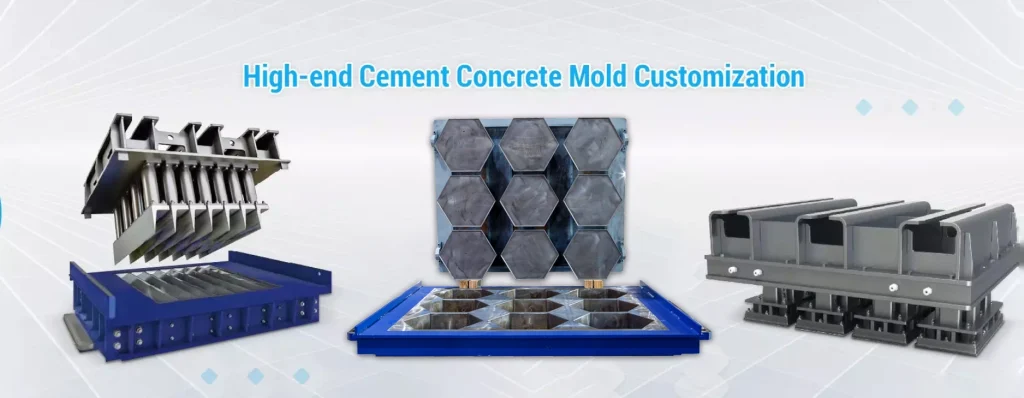What Is The Basic Working Principle Of Interlocking Brick Mold?
10月 9, 2024
Interlocking brick molds have revolutionized the construction industry by providing a sustainable and efficient method for building. These molds are designed to create interlocking bricks that enhance the structural integrity of walls and reduce the need for additional binding materials. Understanding the basic working principle of interlocking brick molds is essential for manufacturers and builders alike.

Basic Working Principle
The core functionality of interlocking brick molds involves several key steps that facilitate the production of durable and precise bricks:
1.Material Preparation: The process begins with the preparation of raw materials, typically a mixture of soil, cement, and aggregates. This mixture is formulated to achieve the desired strength and durability of the bricks.
2.Molding Process: Once the material is ready, it is placed into the interlocking brick mold. The mold is designed with specific shapes and dimensions to create interlocking features in the bricks.
3.Compaction: The filled mold is subjected to compaction, which ensures that the material is densely packed. This step is crucial as it enhances the strength of the bricks. Hydraulic or manual compaction methods can be used, depending on the equipment available.
4.Curing: After compaction, the molded bricks need to cure to achieve their full strength. Curing typically involves keeping the bricks in a controlled environment where they are kept moist for a specified period. This process allows the cement to hydrate properly.
5.Demolding: Once the bricks have cured sufficiently, they are removed from the interlock molds for concrete blocks. The interlocking design allows the bricks to fit together securely, facilitating easy stacking and construction.
6.Quality Control: Throughout the entire process, quality control measures are implemented to ensure that the bricks meet specified standards. This includes checking the dimensions, strength, and interlocking features.
What needs to be considered in the design of interlocking brick molds?
When designing interlocking brick molds, several key factors need to be considered to ensure optimal performance and efficiency. Firstly, the mold’s geometry is crucial; the interlocking features must be precisely designed to ensure that the bricks fit together securely without the need for additional binding materials. This involves careful consideration of dimensions, angles, and alignment to facilitate easy assembly during construction.
Secondly, the choice of materials for the mold itself is essential. The mold must be durable and resistant to wear, as it will undergo repeated use. Selecting high-quality materials can enhance the mold’s lifespan and maintain consistent brick quality over time.
Additionally, the mold’s ease of use should be taken into account, including how easily it can be filled, compacted, and demolded. Designing for efficient handling and reducing labor intensity can improve productivity.
Finally, incorporating features that facilitate drainage and air circulation can help with the curing process, ensuring the bricks achieve the desired strength and durability. Overall, a well-thought-out design of interlocking brick molds can significantly enhance the production process and the quality of the finished bricks.
Application Scenarios
Here’s a table outlining various application scenarios for interlocking brick molds:
| Application Scenario | 説明 |
| Residential Construction | Used for building houses, providing strong, durable walls with reduced material costs. |
| Commercial Buildings | Ideal for constructing commercial properties due to their strength and interlocking capabilities. |
| Road and Pavement Projects | Suitable for creating durable, interlocking pavement blocks for roads and walkways. |
| Retaining Walls | Effective for building retaining walls that require stability and support in landscaping. |
| Boundary Walls | Commonly used for erecting boundary walls, offering security and privacy in residential areas. |
| Garden Structures | Useful for building garden walls, planters, and other decorative structures in landscaping. |
| Emergency Shelters | Quick to assemble and cost-effective for constructing temporary housing in disaster relief efforts. |
| Eco-Friendly Housing | Promotes sustainable building practices by reducing waste and using local materials. |
| Infrastructure Projects | Employed in constructing infrastructure such as schools, hospitals, and community centers. |
| Industrial Applications | Used in industrial settings for creating durable walls and partitions within factories and warehouses. |
As a leading supplier of interlocking brick molds, KBL Machinery is committed to providing high-quality solutions that empower builders and manufacturers to meet their construction needs effectively. We can offer you interlocking block moulds, interlocking brick molds, and interlock moulds for concrete blocks. With the rising demand for eco-friendly building materials, understanding the working principle of interlocking brick molds is more important than ever for fostering innovation and sustainability in the industry.
